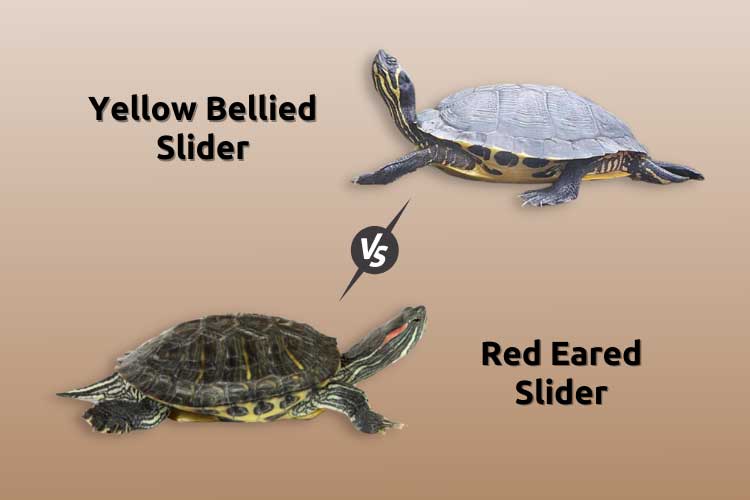Yellow Bellied Slider Vs Red Eared Slider
The yellow-bellied slider and red-eared slider are close cousins belonging to the same family of pond slider turtles. They share many similarities and it can be hard to decide which one to choose for a pet turtle. However, we’ve come up with this guide to help you out.
Yellow-bellied sliders vs red-eared sliders differ in that the yellow-bellied slider has bright yellow coloration in its cheek area as well as body and plastron while a red-eared slider features a small red patch behind its ear.
This guide will discuss more details about yellow-bellied sliders and red-eared sliders, including their physical attributes, care difficulty, lifespan, temperament, diet, cost, and more.
Yellow Bellied Slider Vs Red Eared Slider comparison table:
Contents
| Yellow Bellied Slider (Trachemys scripta scripta) | Red-Eared Slider (Trachemys scripta elegans) | |
| Size | 8 to 13 inches | 5 to 12 inches |
| Diet | Omnivore | Omnivore |
| Temperament | Friendly | Friendly |
| Care difficulty | Beginner | Beginner |
| Cost | $60 to $100 | $10 to $25 |
| Lifespan | 30 to 40 years | 20 to 30 years |
Yellow Bellied Slider Vs Red Eared Slider Comparison (side by side):
Below, we do a side-by-side comparison of these two sliders to bring out their key differences and similarities and help you easily decide which one is for you.
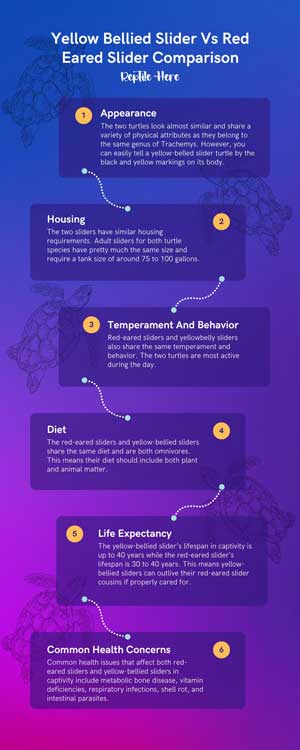
Appearance
The two turtles look almost similar and share a variety of physical attributes as they belong to the same genus of Trachemys.

However, you can easily tell a yellow-belled slider turtle by the black and yellow markings on its body. Its top shell is dark brownish-green and features black and orange wavy lines. The plastron is bright yellow and four dark spots appear on each side of its plastron. As these sliders get older, their shell coloration becomes darker.
Red-eared sliders, on the other hand, have a dark brown to olive upper shell. They feature a yellow plastron in addition to a distinctive red/maroon marking behind their eyes (hence their name). They feature multiple block spots on the scutes.
In terms of size, the adult yellow-bellied slider size has an average size of 5 to 9 inches while a female can reach between 8 and 13 inches.

Red-eared slider adult male reaches between 7 to 9 inches in size while females grow bigger and can go between 10 and 12 inches.
Housing
The two sliders have similar housing requirements. Adult sliders for both turtle species have pretty much the same size and require a tank size of around 75 to 100 gallons.

Their tanks should feature the same water parameters. They should also include a strong water filter, a basking spot with a basking lamp, a water heater to maintain optimal water temperatures, and UV light.
Temperament and behavior
Red-eared sliders and yellowbelly sliders also share the same temperament and behavior. The two turtles are most active during the day. Just like other turtles, they don’t like too much handling, though they can get used to it over time.
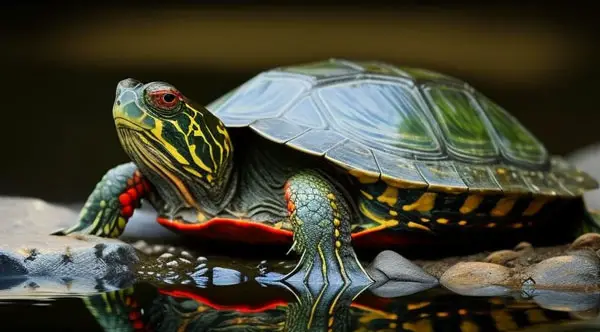
However, the yellow-bellied sliders may bite when they feel scratched. Both sliders are friendly pet turtles, curious, and quite entertaining to watch provided you provided them with the best care.
Diet
The red-eared sliders and yellow-bellied sliders share the same diet and are both omnivores. This means their diet should include both plant and animal matter. Just like other aquatic turtle species, the baby sliders are carnivorous and like feeding on insects and small worms while adults prefer to eat more plant matter and less protein diet.
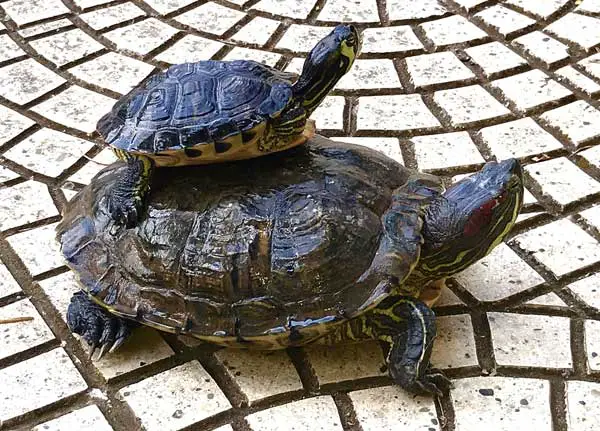
Life expectancy
The yellow-bellied slider’s lifespan in captivity is up to 40 years while the red-eared slider’s lifespan is 30 to 40 years. This means yellow-bellied sliders can outlive their red-eared slider cousins if properly cared for.
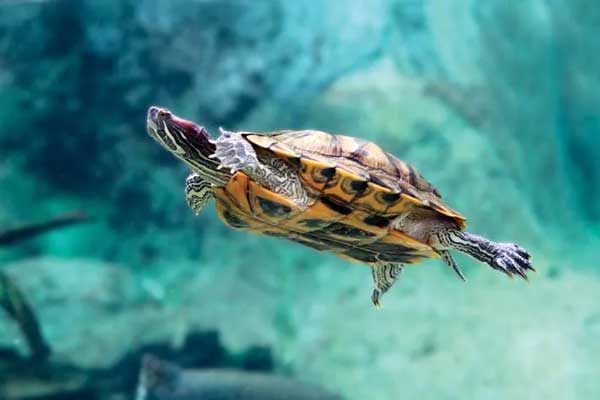
Common health concerns
Common health issues that affect both red-eared sliders and yellow-bellied sliders in captivity include metabolic bone disease, vitamin deficiencies, respiratory infections, shell rot, and intestinal parasites.
You can prevent these aquatic turtle health problems from attacking your pet turtle by taking good care of it, including giving it a healthy diet, ensuring it has perfect living conditions and taking it for regular vet checkups.
Yellow-bellied slider red-eared slider hybrid: is it possible?
A yellow-bellied slider and red-eared slider hybrid is viable. These two turtles can mate as they belong to the same species of turtle known as pond sliders. They even mate in the wild to produce hybrid offspring.

Breeders also successfully mate the two turtles in captivity. Note that the resulting offspring usually look like either of these sliders, so your red-eared slider or yellow-bellied slider could be a product of these intergrades.
Can red-eared sliders and yellow-belly sliders live together?
Both sliders have the same housing and lifestyle requirements, meaning they can live together in the same habitat.
However, it’s worth noting that both turtle species are territorial and can get quite aggressive toward other tank mates. This is especially true if you house sliders of each species that aren’t the same size.
The bigger turtles end up harassing the smaller ones and even compete for food and other resources.
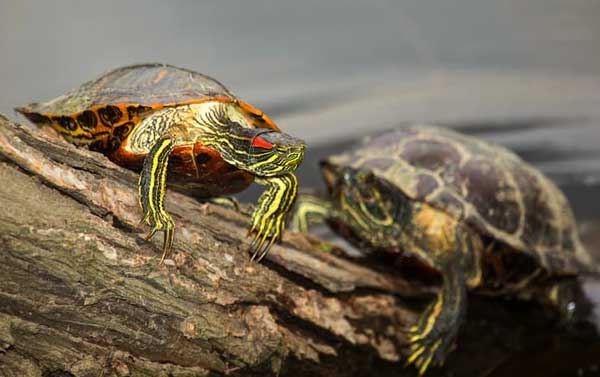
Housing individuals of the same sex can also lead to aggression in the shared aquarium.
If you plan to house these two slider turtle species together, then you should get them a spacious tank space. You may also consider getting a tank divider to prevent fighting between the two sliders.
Can a red-eared slider have yellow ears?
No. A red-eared slider is only recognized by the red streak behind both its eyes. No red-eared slider has been recorded with yellow colorations behind its eyes.
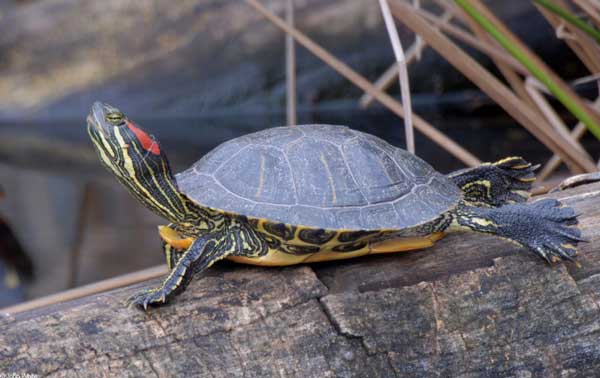
As we mentioned earlier, this streak of red in red-eared sliders is what gives it its name and makes it easily distinguishable from turtle species such as yellow-bellied sliders as well as painted turtles.
Final Verdict
The key difference that sets a yellow-bellied slider from a red-eared slider is the color. While the yellow-bellied slider has bright yellow coloration on its cheek area, the red-eared slider has a streak of red on its ears. Other than that, these two turtles share many attributes including housing, behavior and temperament, diet, size, and common health issues. Both sliders will make great beginner pets and are friendly toward their owners and will rarely scratch or brie unless you overhandle them.


